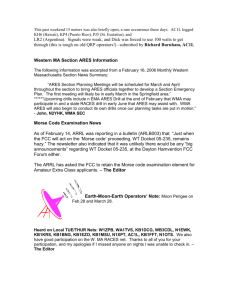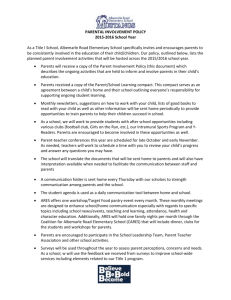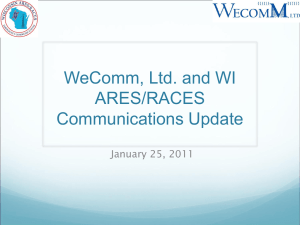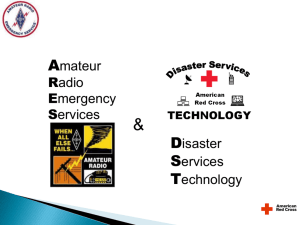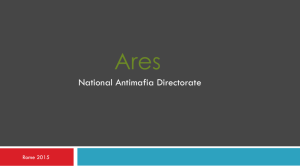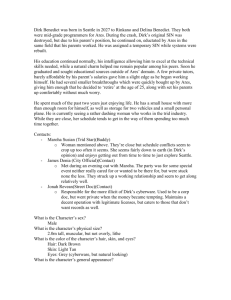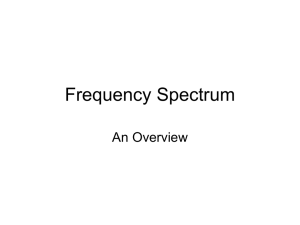2010 Homeland Security Conference Presentation
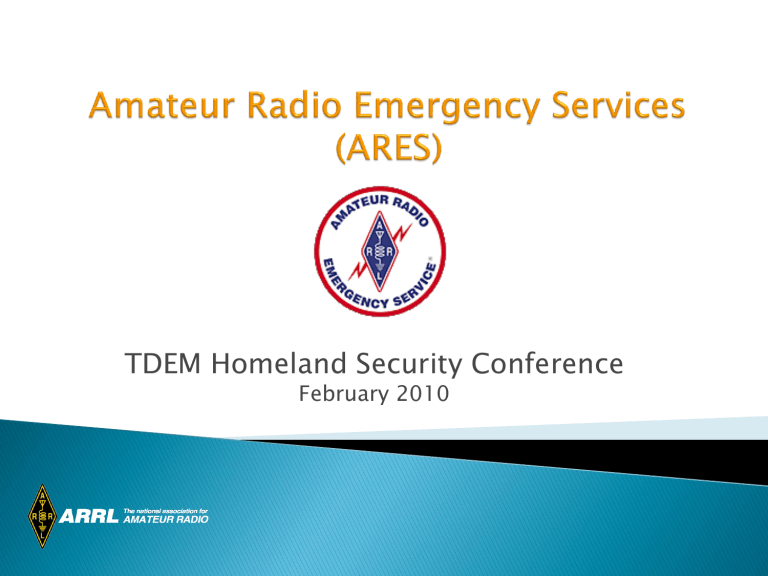
TDEM Homeland Security Conference
February 2010
ARES
Amateur Radio support is provided by a consortium of volunteer radio organizations, including the Military
Auxiliary Radio System (MARS), the Amateur Radio
Emergency System (ARES) and the Radio Amateur Civil
Emergency Service (RACES).
Each service has a different structure, capabilities, and limitations.
We will discuss preparations needed to integrate these services into your Emergency Operations Center,
Disaster District and Re-Entry Task Force operations; which organization is most appropriate for the mission; and what kind of support the organization will need.
In 1912, Congress passed the first laws regulating radio transmissions in the U.S.
By 1913, the first Amateur experimenters were communicating nationwide.
In 1927 the FCC created the Amateur Radio Service to fill the need for a pool of experts that could provide backup emergency communications.
And the rest, as they say, is History…… ..
ARES
ARES
Is ARES recognized as an Emcomm Partner?
At National and Local levels we have MOU’s with:
Department of Homeland Security
Federal Emergency Management Agency
National Communications System
American Red Cross
Salvation Army
National Weather Service
Association of Public Safety Communications Officials
What are some examples of disasters
Amateur Radio has responded to?
Hurricanes Katrina and Rita – August 2005 *
Hurricane Isabel -- September 2003
Northeast blackout -- August 2003
Midwest tornadoes -- May 2003
Shuttle Columbia recovery effort -- February 2003 (300 hams!)
Wildfires in Colorado -- June 2002
World Trade Center and Pentagon terrorist attacks --
September 2001
Flooding in Texas -- October 1998
Jarrell, Texas – May 1997
* Recognized in Federal reports as a “What went right”
ARES
Amateur Radio operators set up and operate organized communication networks locally for governmental and emergency officials, as well as non-commercial communication for private citizens affected by the disaster.
Amateur Radio operators are most likely to be active after disasters that damage regular lines of communications due to power outages and destruction of telephone lines .
ARES
They are trained in communications procedures so that they can work effectively within disaster organizations and in communicating between them.
There are over 51,000 amateur operators in Texas, forming a huge resource of people and equipment that can respond to a wide variety of needs.
They are trained and equipped in many radio technologies and can select the technology that will work for a particular need.
ARES
Amateur Radio Emergency Services
What is the structure of the ARES?
How are we organized at the national, regional and local levels?
ARES
ARES
Nationwide – 650,000 hams (51,000 in Texas)
Field Organization consists of:
15 Divisions
71 Sections
Texas has 3 sections (North, South, West)
Approximately 4000 registered and trained ARES members in state
There are four levels of an ARES organization
ARES
ARES
ARES
County Emergency Coordinator (EC) or District
Emergency Coordinator (DEC)
www.arrlstx.org
for contact list
ARES
ARES
HF Voice /Data
Local UHF /VHF
Radio Linked repeaters
Internet Linked repeaters
High Speed Multimedia (HSMM)
GPS location /Tracking
Image capture and transfer via radio (SSTV)
Digital Mode linked repeaters (D-STAR)
What are the anticipated missions of ARES?
Where does it align with MARS and RACES?
ARES
ARES
• Texas Military Forces
• Mobile Task Forces
• (HF Winlink to TDEM SOC)
ARES
• DDC to SOC Communications, “Starship”
ARES
•Mobile Task Forces to SOC
•County /Local to DDC
•Shelters
•PODs
•Hospitals
•Other as needed
* HF and Linked nets may be run as cross organizational org nets
ARES
ARES
*Also provide comms to CCG via SOC or Austin EOC
ARES
What support and coordination is needed for volunteer group from the supported organizations ?
Operating space /locations (especially tower space)
Integrated training with agency
Inclusion @ table with ongoing planning efforts
Inclusion in Agency Emergency Response plans
Consideration of use of grant monies to purchase “High
Dollar” items.
Consider all areas such as inclusion in JIC for PIO’s.
Regular meetings /reviews to identify opportunities
ARES
ARES
Services / Capabilities
ARES
ARES
Uses e-mail , the World’s standard for written communications.
Provides “last Mile” local radio digital messaging directly for served agencies, using existing e-mail programs or Airmail clients.
Provides wide area coverage from inside a disaster area without the Internet.
Has a proven record of reliability, and continues to be responsive to the needs of its user communities
E-MAIL VIA VHF or HF RADIO
Airmail /Winlink can provide e-mail to any served agency without the internet within the “Last Mile,” across the Nation, or around the World.
You can send radio email directly to internet e-mail users .
Radio
Data
Interface
Comput er
Radio
Data
Interface
PMBO
The Internet
South Texas ARES Winlink
2005 2006 2007
2008 2009
South Texas Winlink Remote Mail Server Packet stations: 18 40 54 62
64
ARES
South Texas ARES Winlink
Telpac Coverage
Jan 2008
South Texas ARES Winlink http://n5tw.ecpi.com/RMSstatus
South Texas ARES Winlink
Texas EMCOMM Winlink PMBO now RMS HF stations
2006: Harris County (W0MAC)
Williamson County (N5TW)
2007: Cameron County (AE5R)
Harris County (W0MAC)
Harris County (KB5HCD)
Williamson County (N5TW)
2008:
Cameron County (AE5R)
Guadaloupe (W5SEG)
Harris County (W0MAC)
Harris County (KB5HCD)
Williamson County (N5TW)
South Texas ARES Winlink
Texas Winlink VHF PMBO now RMS Relay stations
2006: Harris County *
Williamson County *
2007: Above plus:
Cameron County *
Travis County * (1)
2008: Above Plus:
Bexar County
Calhoun County
Guadalupe *
Sabine County
2009: Above Plus:
Angelina
Nueces * (1)
* Indicates HF Forwarding
1 Planned for near term
Note: Task force stations with SCS PACTOR III TNCs can be run as portable RMS Relay Stations!
South Texas ARES Winlink
Router
Distant RMS PACTOR Server
RMS Pactor Pactor TNC HF Radio
CMS 1
CMS 2
CMS 3
CMS 4
X
ARES Texas Reentry Task Force VHF server with HF forwarding
Pactor TNC HF Radio
Router RMS Relay
RMS Packet Packet TNC VHF Radio
X
Router Client
Local VHF / HF Client
Pactor TNC
Packet TNC
HF Radio
VHF Radio
ARES
Services / Capabilities
ARES
Base, Mobile and Handheld communications capability.
Linked Systems throughout state
FULL Interoperability between all 254 counties within Texas,
US and Worldwide.
ARES
ARES
Linked Repeater System
Repeater to repeater (linking w/o hardware)
EOC to National WX Service
WX service to WX service offices
EOC to National Hurricane Center
Potential communications anywhere in world.
ARES
ARES
Services / Capabilities
• Program started in Travis County in 2000. It was born out of a need by EM to track patient status and location during large scale MCI’s.
• Consists of a network of Voice and Data stations permanently installed at all local area hospitals, EOC’s and Red Cross.
• The concept has grown throughout many areas of Texas. Although coordinated with local EOC’s it is becoming commonly sponsored by the Regional Advisory Councils such as CATRAC in Central
Texas.
ARES
Patient arrives to hospital
Patient is Admitted,
Triage tag info given to ham
Ham Operator transmits data to EOC
ARES
EOC
Data Flows from all
Hospitals into the
Emergency
Operations Center
With permanently installed stations we are able to deploy to medical facilities and be up and running in minutes versus hours.
Standardized equipment simplifies training and expands stations without Hams having to own / bring own equipment.
Assist with event mitigation
Increased situational awareness
ARES
ARES
The National Weather Service conducts spotter training classes across the United States, and your local National
Weather Service office should be consulted as to when the next class will be held.
Severe Weather Nets – These are Amateur Radio nets that are held by NWS trained spotters to report a severe weather condition in progress. These reports are then relayed to the
NWS.
ARES
ARES
Services / Capabilities
ARES
Services / Capabilities
ARES
D igital S mart T echnology for A mateur R adio
• Digitally modulated voice /data communications
• Simultaneous voice & data capability
• Internet linked gateways for world-wide comms
• High speed (128K) and Low Speed data
• Multiple applications for sending data, location and Instant messaging type data
RPT2 = KF6BQK G
RPT1 = KF6BQK B
VK8RAD G
/VK8RADC
OR
VK8HF
= UrCall
ARES
San Antonio
WD6FZA = MyCall
TALKING TO
VK8RF
D-STAR Radio Entries
Miami Hurricane Center
VK8HF
ARES
ARES
ARES
• Alabama DEM has invested over 100K in DSTAR
• State of Washington recently announced
250K investment
• Club repeaters growing in Texas
ARES
Services / Capabilities
ARES
Services / Capabilities
ARES
Services / Capabilities
• Amateur Radio developed technology
• Network Speeds (10 megabit or better)
• Mesh connectivity modes
• Uses low cost, easy to obtain equipment
ARES
Mesh node visual
ARES
Services / Capabilities
• Ability to take digital photos and send them via AR
Disaster Intelligence and
Situational Awareness
ARES
Weather Reporting
Damage Assessment
Monitoring Critical Resources
Monitoring Critical Infrastructures
Communications Resource Augmentation
Communications Infrastructure Support
Data can be shared with various agencies with
Amateur Radio Operators providing this data via
Amateur Radio
Phone etc.)
or other means
(Internet, Email,
Agencies that can benefit from this data sharing:
◦ FEMA
◦ National, Regional and local NWS Offices
◦ State Emergency Management
◦ Local Emergency Management
◦ Non-Governmental Organizations
Amateur Radio Operators can monitor various sources of information for data, including;
◦ Deployment of Hams to critical infrastructures and sites that need monitoring prior to the disaster.
◦ Internet web sites, Twitter, instant messenger/chat, blogs, radio and TV stations
◦ Public Safety personnel via radio scanners and
Internet scanner feeds
Information from Hams deployed to critical infrastructure or simply see critical public safety issues developing results in critical data that can be shared and validated as first hand data.
Data from web bloggers, twitter, people on instant messenger and media can be confirmed through pictures and written confirmation of what’s occurred.
Data from public safety personnel via radio scanners can be validated by confirmation that the mobile unit has confirmed the damage or dispatch has confirmed the damage from the caller.
Amateur Radio supports NGOs with shelter communications and mass care activities. In many cases disaster damage assessment is also a critical role .
Information on issues that are discovered in the course of this work, particularly structural damage issues or other similar problems are essential pieces of information and create critical disaster intelligence to Emergency Management, the
National Weather Service, the National Hurricane
Center and NGOs.
Dissemination of this information across multiple
Amateur Radio Nets at the local, state and national level can provide access to many agencies supporting disaster relief and to allow for better updated surface conditions for meteorologists.
EOC Amateur Radio Operators can perform similar acts from city/town, county and State Emergency
Operation Center locations.
Hurricane Ike – 2008
Amateur Operators were active on IRLP Reflector
9455 with a SKYWARN Net, National Weather
Service and local EOC’s active. Information was relayed from that net to the VoIP Hurricane Net.
ARES/RACES net forwarded constant Intel on open gas stations & grocery stores, road conditions,
Power outages, etc to State Operations Center
Continual updates were provided from Galveston during storm via Amateur Radio.
AR provided POD situational awareness and needs to FEMA in Houston area.
Fargo ND Flooding:
Amateurs were used to monitor makeshift flood walls to watch for leaks and potential breaches thus freeing up Fire and Police to handle life threatening situations
Skywarn reports allow for verification of data being received from multiple sources. Helps confirm accuracy of reports.
Hurricane Katrina in 2005 and the Levee breach
What if the levee breaches were detected sooner before they completely let go? Could additional safety actions been taken before the flood occurred?
The lack of knowing the significance of those breaches ahead of time and potentially being able to take action hurt any mitigation before the levee breach occurred.
This is an area where Amateur Operators working with Emergency Management providing information
/disaster intelligence could be vital in mitigating a disaster .
Amateur Radio can integrate with agencies as follows:
Classes and training within CERT (Citizen
Emergency Response Team) teams for interested team members to become Amateur Radio
Operators.
Include Amateur Radio wherever possible in training, exercises and actual events understanding how to properly manage volunteers.
Recognition of Amateur Radio voluntary resources in the roles of not just passing messages but gathering critical disaster intelligence data and the ability to share data across agencies.
Inherent interoperability of the system allows for many agencies to tie together in a disaster if many agencies utilize the Amateur Radio resources
Disaster Intelligence gathering by Amateur Radio
Operators is an underutilized and critical resource that can contribute to disaster responses and is critical for when communications systems fail .
Creates a new motto of “Before it fails, Amateur
Radio Gives Situational Awareness” and also better prepares Amateur Operators when and if normal communications channels fail.
Conclusions
We strongly recommend that Emergency
Management does the following:
◦ Include Amateur Radio to be a part of your emergency management ESF #2 function or NGO communications structure.
◦ Integrate Amateur Radio Operators into CERT and other citizen based volunteer programs to allow for well trained emergency communication volunteers.
Conclusions
◦ Emergency Management should be active in the local SKYWARN program for severe weather events for all seasons and provide pertinent information per the NWS SKYWARN reporting criteria.
◦ Utilize Amateur Radio Operators to monitor critical infrastructure to give reports first-hand.
◦ Utilize and train Amateur Radio Operators to monitor all Internet resources and public safety frequencies and properly document and validate information from these sources to create critical disaster intelligence.
Conclusions
◦ If Hams are actively performing all these functions, are well trained, and properly connected with your agency, you will have the situational awareness to know if something will fail so you can react proactively. This is where Hams become a vital resource in the emergency management structure in a new and vital way.
The ONLY reliable communications source when disaster strikes!
Not tied to any specific systems
Flexible
Portable
Cost effective
Solution oriented
Did you know?
Other than NASA and Military, only Amateurs allowed to communicate with International Space Station.
ARES
QUESTIONS?
Lee Cooper, W5LHC
South Texas Section Manager
Assistant Director Emergency Communications
Communication Coordination Group (CCG) Amateur Radio Rep.
State Races County Liaison Officer (Alt) w5lhc@arrl.org
ARES

